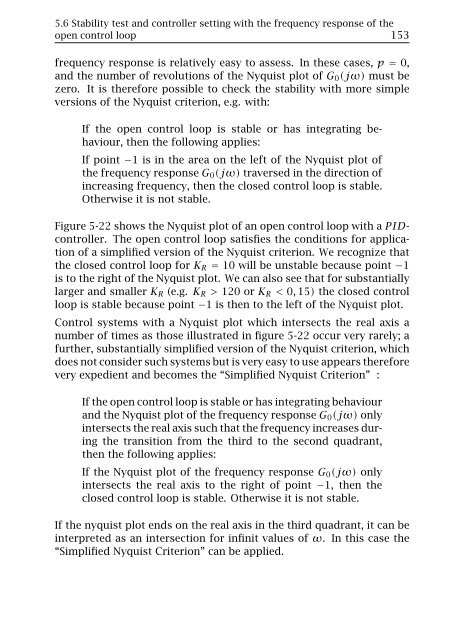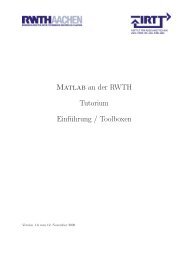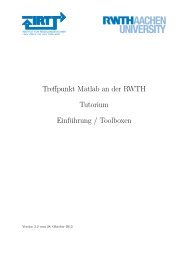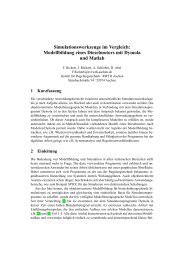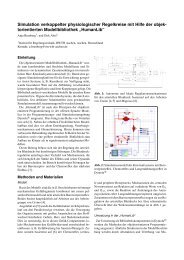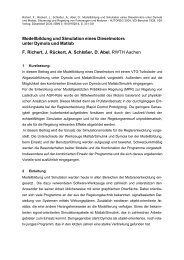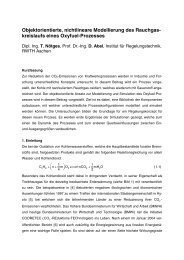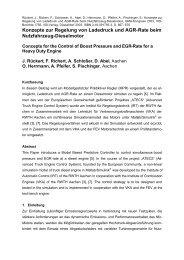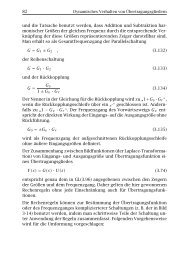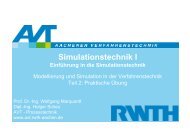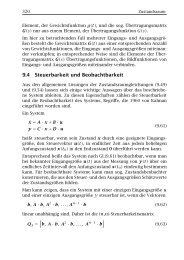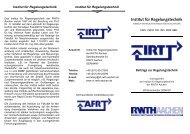Simplified Nyquist Criterion
Simplified Nyquist Criterion
Simplified Nyquist Criterion
You also want an ePaper? Increase the reach of your titles
YUMPU automatically turns print PDFs into web optimized ePapers that Google loves.
5.6 Stability test and controller setting with the frequency response of the<br />
open control loop 153<br />
frequency response is relatively easy to assess. In these cases, p = 0,<br />
and the number of revolutions of the <strong>Nyquist</strong> plot of G 0 (jω) must be<br />
zero. It is therefore possible to check the stability with more simple<br />
versions of the <strong>Nyquist</strong> criterion, e.g. with:<br />
If the open control loop is stable or has integrating behaviour,<br />
then the following applies:<br />
If point −1 is in the area on the left of the <strong>Nyquist</strong> plot of<br />
the frequency response G 0 (jω) traversed in the direction of<br />
increasing frequency, then the closed control loop is stable.<br />
Otherwise it is not stable.<br />
Figure 5-22 shows the <strong>Nyquist</strong> plot of an open control loop with a PIDcontroller.<br />
The open control loop satisfies the conditions for application<br />
of a simplified version of the <strong>Nyquist</strong> criterion. We recognize that<br />
the closed control loop for K R = 10 will be unstable because point −1<br />
is to the right of the <strong>Nyquist</strong> plot. We can also see that for substantially<br />
larger and smaller K R (e.g. K R > 120 or K R < 0, 15) the closed control<br />
loop is stable because point −1 is then to the left of the <strong>Nyquist</strong> plot.<br />
Control systems with a <strong>Nyquist</strong> plot which intersects the real axis a<br />
number of times as those illustrated in figure 5-22 occur very rarely; a<br />
further, substantially simplified version of the <strong>Nyquist</strong> criterion, which<br />
does not consider such systems but is very easy to use appears therefore<br />
very expedient and becomes the “<strong>Simplified</strong> <strong>Nyquist</strong> <strong>Criterion</strong>” :<br />
If the open control loop is stable or has integrating behaviour<br />
and the <strong>Nyquist</strong> plot of the frequency response G 0 (jω) only<br />
intersects the real axis such that the frequency increases during<br />
the transition from the third to the second quadrant,<br />
then the following applies:<br />
If the <strong>Nyquist</strong> plot of the frequency response G 0 (jω) only<br />
intersects the real axis to the right of point −1, then the<br />
closed control loop is stable. Otherwise it is not stable.<br />
If the nyquist plot ends on the real axis in the third quadrant, it can be<br />
interpreted as an intersection for infinit values of ω. In this case the<br />
“<strong>Simplified</strong> <strong>Nyquist</strong> <strong>Criterion</strong>” can be applied.
160 Controller setting and stability of control loops<br />
5.6.3 Controller design in the Bode diagram<br />
For the practical treatment of linear control systems the representation<br />
of frequency responses in the Bode diagram is preferred above that by<br />
the <strong>Nyquist</strong> plots because the former method is simpler by far. The<br />
statements on the stability of a closed loop provided by the <strong>Nyquist</strong><br />
criterion can be transferred to the representation of the frequency response<br />
of the open control loop in the Bode diagram. This shall only<br />
be dealt with in the following text within the context of the “<strong>Simplified</strong><br />
<strong>Nyquist</strong> <strong>Criterion</strong>”.<br />
As illustrated in figure 5-26, we can, for stability testing with the “<strong>Simplified</strong><br />
<strong>Nyquist</strong> <strong>Criterion</strong>” determine the frequency ω π from the phase<br />
response with the definition ϕ 0 (ω π ) =−π and check whether the amplitude<br />
of the frequency response |G 0 (jω π )| is less than one. Alternatively,<br />
with the definition |G 0 (jω d )|=1 we can obtain from the amplitude<br />
response the frequency ω d and check whether the phase angle<br />
ϕ 0 (ω d ) is greater than −π.<br />
We must ensure in every case that the “<strong>Simplified</strong> <strong>Nyquist</strong> <strong>Criterion</strong>” is<br />
applicable.<br />
Summarizing, the “<strong>Simplified</strong> <strong>Nyquist</strong> <strong>Criterion</strong>” for the application in<br />
the Bode diagram gives:<br />
If the open control loop is stable or has integrating behaviour<br />
and the phase response of its frequency response in the Bode<br />
diagram intersects the lines −180 ◦ − n · 360 ◦ with a negative<br />
slope only, then the following applies:<br />
If the amplitude of the frequency response |G 0 (jω π )| is less<br />
than one at frequency values for which the phase response<br />
gives ϕ 0 (ω π ) =−180 ◦ − n · 360 ◦ , then the closed control<br />
loop is stable. Otherwise it is not stable.<br />
For the “<strong>Simplified</strong> <strong>Nyquist</strong> <strong>Criterion</strong>” the point where the phase response<br />
is just tangent to the line −180 ◦ − n · 360 ◦ for infinit values of<br />
ω has to be considered.<br />
Figure 5-26 also shows that it is possible to obtain the gain margin<br />
from the amplitude response |G 0 (jω π )| and the phase margin from<br />
the phase response ϕ 0 (ω d ).


